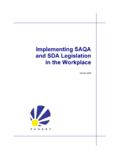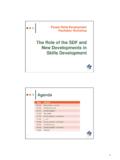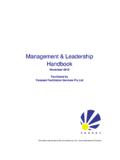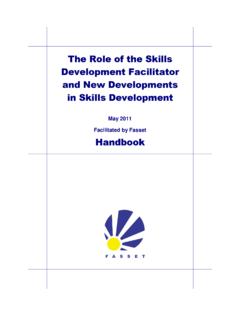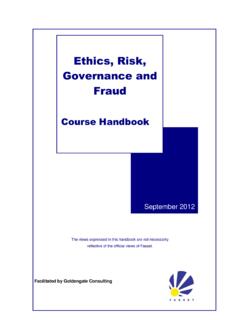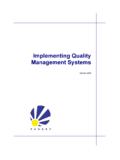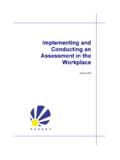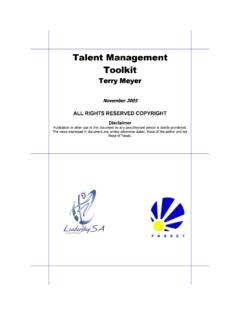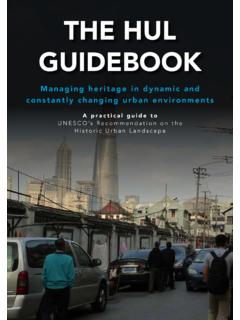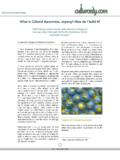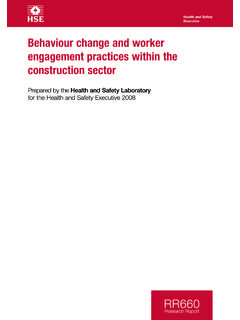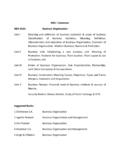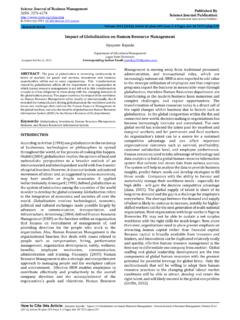Transcription of February/March 2012 - Fasset
1 Essential Office EtiquetteFebruary/ march 2012 Essential Offi ce EtiquetteFacilitated by ATTE - The Training Edge (Pty) LtdFebruary/ march 2012 ALL RIGHTS RESERVED COPYRIGHTThe views expressed in this document are not necessarily those of the Seta sContents-i--i-CONTENTSCONTENTSF oreword/Introduction ..iiiLearning Map ..ivSession 1: Etiquette and Rules of Behaviour ..1 Personal Behaviour ..2 Polite Society ..2 Conventional Rules ..3 Session 2: Dealing with Colleagues ..5 The Elements of a Relationship ..6 Displaying Aff ection ..10 Addressing Colleagues ..10 Conversations at Work ..11 Etiquette for Personal Contact ..12 Romantic Interaction ..16 Sexual Harassment ..17 Accommodating Colleagues with a Disability ..18 Session 3: Professional Conduct ..21 Professional Communication ..22 Communication Styles ..23 Using Body Language.
2 27 Your Professional Image ..31 Session 4: Dealing with Di cult People and Issues Professionally ..39 Dealing with Personal Issues ..40 Dealing with Diffi cult people ..40 Dealing with Ethical Dilemmas ..43 Contents-ii-Essential Offi ce Etiquette 2012 -ii-CONTENTSCONTENTSS ession 5: Etiquette in Meetings ..47 managing a Meeting ..48 Formal Meetings ..49 Informal Meetings ..50 Session 6: Netiquette ..53 Internet Usage Policy ..54E-mail Etiquette ..54 Telephone Etiquette ..62 Cell Phone Etiquette ..66 Session 7: Etiquette in and around the O ce ..69 Open Plan Offi ce Etiquette ..70 Communal Kitchen Etiquette ..72 Offi ce Party Etiquette ..74 Confi dentiality: Code of Professional Conduct ..77 Dealing with Confi dential Issues in the Offi ce ..80 Session 8: Business Entertainment the Professional Way ..85 Entertaining Associates.
3 86 Aannexure ..97 Icons-iii--iii-FOREWORD/ INTRODUCTIONYou have chosen Business Etiquette as one of your continuous professional development activities for 2012 . We are going to have fun but when you have completed the program you will be able to: Identify and correct protocols for business etiquette for a range of business scenarios Apply the techniques required to build and project a professional image through professional behaviour Describe appropriate and inappropriate behaviour in a range of workplace settings FOREWORD/ INTRODUCTIONP rogramme Map-iv--iv-PROGRAMME MAPPROGRAMME MAPS ession 1: Etiquette and Rules of BehaviourSession 3: Professional ConductSession 5: Etiquette in MeetingsSession 2: Dealing with ColleaguesSession 4: Dealing with Diffi cult People and Issues ProfessionallySession 6: NetiquetteSession 7: Etiquette in and around the Offi ceSession 8.
4 Business Entertainment the Professional WayEssential Offi ce Etiquette 2012 Essential Offi ce Etiquette 2012 DELEGATE GUIDES ession 1 Etiquette and Rules of BehaviourThe etiquette of business is the set of written and unwritten rules of conduct that make social interactions run more smoothly. Offi ce etiquette in particular applies to co-worker interaction, excluding interactions with external contacts such as customers and suppliers. These rules are often echoed throughout an industry or economy. For instance, 49% of employers surveyed in 2005 by the American National Association of Colleges and Employers found that non-traditional attire would be a strong infl uence on their opinion of a potential job offi ce and business etiquette overlap considerably with basic tenets of netiquette, the social conventions for using computer 1-2--2-Personal BehaviourPersonal behaviour indicates that etiquette is something we acquire and practise as individuals.
5 You learn appropriate behaviour at home, how to speak to adults, how to eat in a proper manner and how to use a telephone. This is further taught at school and as a young adult entering the business world, you knew how to conduct yourself in a polite society. We must take cultural and religious backgrounds into account when we discuss etiquette. Offi ce etiquette therefore has some standard rules, which can be learnt and practised on a daily SocietyPolite society is about order, about respect for others and about earning their respect in return. As proper behaviour in your own community is important, so is it in the offi ce, thus having mutual respect for people who have diff erent cultures and views. EXAMPLEYou may believe that eating with a knife and fork is correct, but your Chinese colleague may believe chopsticks are the proper 1-3--3-Conventional RulesThe rules of offi ce etiquette are unique to every organisation and it is important that you understand the rules in your environment in order to succeed.
6 Questions you may ask include: Whose rules of conduct do I follow? What is the appropriate behaviour? Will I be appropriately dressed? Those who have mastered the rules of etiquette will instinctively know the answers to these questions. They might respond as follows; I will conduct myself according to the conventional rules of my host, superior or the person to whom I wish to show respect. How you greet someone, how you dress, how you eat, the way you write letters, how well you make a presentation; all of these can make the diff erence between sending the correct message, making the right impression, or not making a good impression, which might ruin a great Offi ce Etiquette 2012 Session 1-4--4-NotesNotesEssential Offi ce Etiquette 2012 DELEGATE GUIDES ession 2 Dealing with ColleaguesThere are many defi nitions for relationship management but defi nes it as follows: It is the process of establishing a mutually bene cial relationship with other business people and potential clients and/or are needed for every facet of your career.
7 From the interview for your fi rst job to your speech at your retirement party relationship skills are the common denominator for nearly all successful employees. In fact, research has found that as many as 80% of rst job graduates who are red during their rst year of work are let go because they don t have adequate relationship skills and cannot get along with co-workers (NACE, 2000).Session 2-6--6-The Elements of a Relationship To begin, let s look at six necessary elements to any positive relationship. Perhaps you can assemble a more impressive, more complex list, but these comprise a core from which you can build any treat yourself as worthy of attention, esteem, regard, and consideration is the fi rst step. Just as charity begins at home, respect begins with oneself. You cannot give what you don t have and you cannot respect another person without a healthy dose of RespectThis critical element must fl ow freely through the relationship, from yourself to the other individual and back to you again.
8 It must continue for the relationship to be degree of compassion is necessary in any relationship, even a business relationship that is going to endure past necessity. Many relationships based on self-interest, without honest compassion, can exist briefl y but only for a specifi c purpose. Compassion assumes a genuine concern for the other, and never with an agenda. Session 2-7--7-Essential Offi ce Etiquette 2012Co-operationOperating in a joint eff ort, towards a common purpose builds relationship strength as surely as any muscle building activity builds physical strength. We hear about building a team from the time we are old enough to play soccer or netball, but many of us cast it aside when we outgrow the Trust With team work comes mutual trust. It is reliance based on the truthfulness, character, integrity, and the proven ability of the other individual, as you experience it over time.
9 Trust is always earned through experience with the other person and there s no way around it. You cannot demand it and you cannot fake must make deposits to the relationship account and only then can you withdraw the is an agreement, a pledge, and it must be 100% there to count. It s an all or nothing undertaking. Commitment is nothing more than a decision and, like most decisions, it s only diffi cult if it s avoided. Sitting on the fence has never been comfortable! Once the decision is made, the execution follows along 2-8--8-Another potential stumbling block to establishing positive relationships is the assumption that other people view the world in the same way that you do. There are many forms of diversity that can lead to misunderstandings and undermine trust. These include: Communication stylesAll people do not communicate in the same way.
10 There are many inventories available to identify diff ering styles and we will explore this in more detail later. Once you understand a person s communication style, this knowledge can lead to respect rather than confl ict. Non-verbal communicationAll forms of communication must be considered. This form of communication is less obvious, but no less important. Non-verbal communication includes body language, and tone of voice. Non-verbal communication may diff er from the verbal. With this additional understanding of what is really being communicated more eff ective collaboration is possible. Learning stylesPeople learn in diff erent ways. People gather information, make decisions and think about the world in their own way. Appreciating that others experience the world diff erently form the way that you do means you can be more open to their approach.
